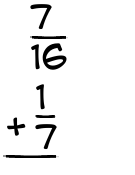What is 7/16 + 1/7?

|
This is how we add
|
|||||||||||
Step 1Can you add yet? Nope! The denominators don't match. We need a common denominator. So next we take both denominators and multiply them. Next, take each numerator and multiply it by the denominator of the other term. So, we multiply 7 by 7, and get 49, then we multiply 16 by 7 and get 112. Now for the second term. You multiply 1 by 16, and get 16, then multiply 16 by 7 and get 112. We now have a new problem, that looks like this:
|
|||||||||||
Step 2Since our denominators match, we can add the numerators. 49 + 16 = 65 That gives us the sum, which is
|
|||||||||||
Step 3Now, do we need to simplify this fraction? First, we attempt to divide it by 2... Nope. Try the next prime number, 3... Nope. Try the next prime number, 5... Nope. Try the next prime number, 7... Nope. Try the next prime number, 11... Nope. Try the next prime number, 13... Nope. Try the next prime number, 17... Nope. Try the next prime number, 19... Nope. Try the next prime number, 23... Nope. Try the next prime number, 29... Nope. Try the next prime number, 31... Nope. Try the next prime number, 37... Nope. Try the next prime number, 41... Nope. Try the next prime number, 43... Nope. Try the next prime number, 47... Nope. Try the next prime number, 53... Nope. Try the next prime number, 59... Nope. Try the next prime number, 61... Nope. Try the next prime number, 67... No good. 67 is larger than 65. So we're done reducing. Congratulations! Here's your final answer to 7/16 + 1/7
|